Faceted search can help you increase conversion rates and improve ecommerce outcomes. In this guide, we will cover the foundations of ecommerce faceted search, provide best practices, and give some actionable examples to improve your customer experience.
When customers come to your site, they are likely on a mission to find something specific and search is the fastest way to connect them to the products they want. But broad search queries like “women’s summer dresses” can return hundreds of results.
Faceted search is a shortcut for buyers, allowing them to filter through result pages and refine their search to find exactly the right item. It’s also a shortcut for businesses to drive more conversions and revenue and create better shopping experiences that inspire long-lasting customer loyalty.
Table of Contents
Faceted Search vs. Faceted Navigation
Faceted search can sometimes be confused with faceted navigation. The difference is where they appear on your website. Faceted search applies to filterable results on your search engine’s results page. Faceted navigation, on the other hand, applies to the filterable items on general category pages as a customer is browsing.
For instance, if you search for “women’s dresses” on Target Australia, the search results page will automatically show dresses that fit the “women’s” and “dresses” categories. There will be additional facets and filters to narrow down your search results from there.

Sometimes sites may pre-build facets and filter selections into their search results. Birkenstock does this well by pre-selecting the black option for the search “black shoes.” Scrolling further below even shows the left-side filter with “Black” pre-selected under the Color category.
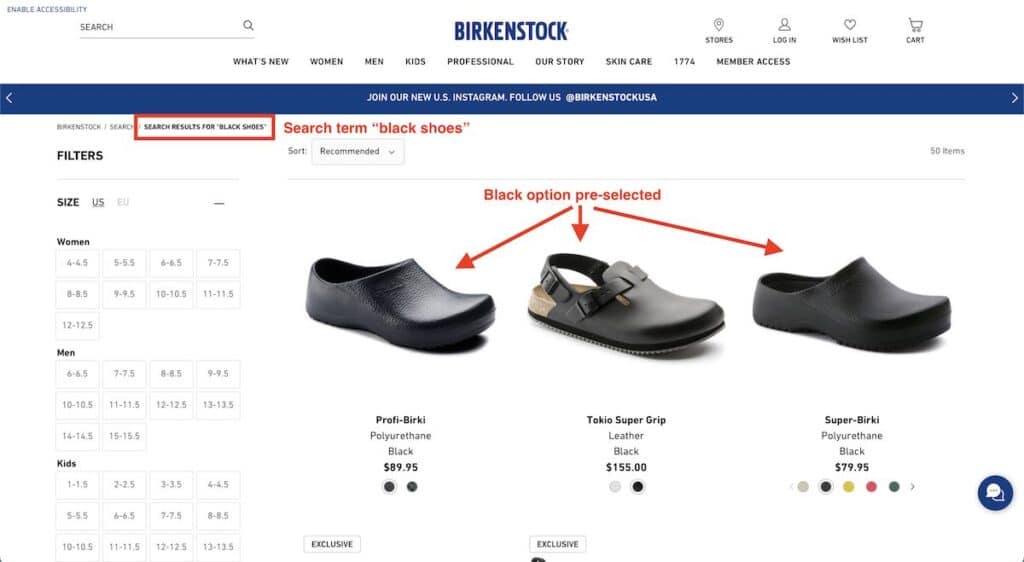
While the difference between ecommerce faceted search and faceted navigation is pretty straightforward, small optimizations like the color filter selection above can have an outsized impact on your customer experience.
Here’s what to keep in mind as you build out your product search strategy.
5 Best Practices for Ecommerce Faceted Search
1. Should You Expand or Collapse Your Filters?
For large ecommerce sites and complex product categories, it’s easy for facets to become unwieldy. When collapsed, it’s easy for a customer to see all their options. Expanded facets show all the attribute details but may be confusing for customers.
A best practice is to collapse most facets and expand or highlight only the most relevant ones for the search string or category. For instance, for the query “spf foundation,” beauty retailer Sephora highlights a few facets most likely to be attractive to customers at the very top (like “vegan” ingredients or “mini” size).

It also expands the location so customers can filter by fulfillment option—important when you might want to sample foundation in store before purchasing it—and collapses the rest of the filters below.
It’s important to collapse your list of filters when it contains a lot of attributes. This makes it easier to display and easier for your customers to find the facets they’d like to filter by. Your mobile experience should also default to collapsed to optimize for the small amount of space on a mobile screen.
2. What are the right facets for your query?
Providing the right facet for your query can improve your user’s experience and boost your conversions by connecting customers to the right products faster. The facets you provide will broadly be divided into a few categories:
Common facets
The most common facets that you will provide to your users are common to most products. These may include size, brand, price range, product category and subcategory. Depending on the type of products you sell, you may provide some additional facets as standards. For instance, when searching for healthy snacks, it may be useful to provide a facet for diet type.
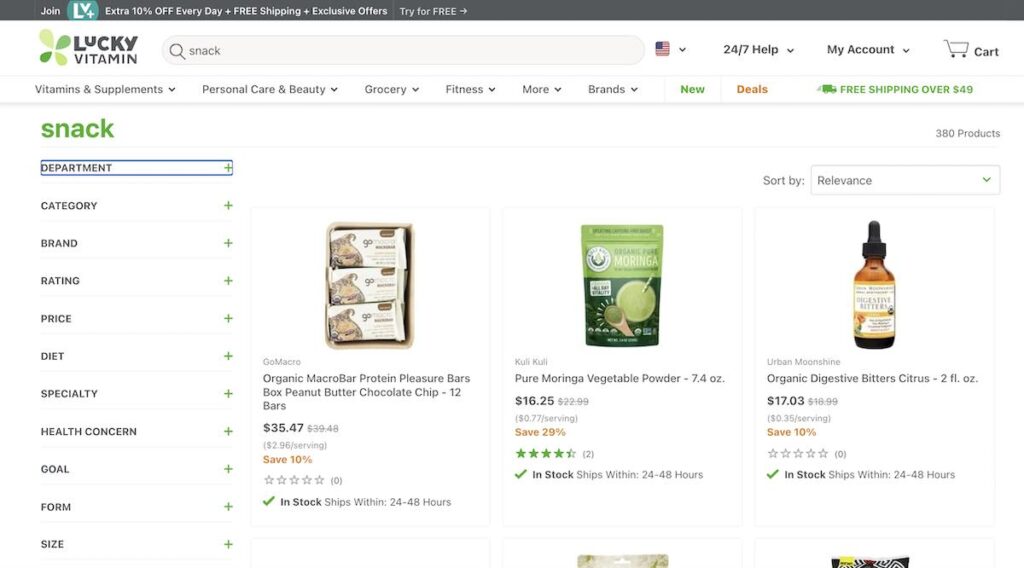
Thematic filters
In many industries, themes matter and can help customers find the right products. For the query “dog card” on greeting card site American Greetings, the website displays facets for both “occasion” and “recipient” to help shoppers find the right card.

This type of faceted search has a number of applications for apparel retailers as well. Customers looking for a dress could shop by style (like maxi dress or cocktail dress) or event (like a wedding or a date night out).
In the absence of an in-store associate, thematic filters coordinate with shopping intent and with how humans think about shopping: “I need a Christmas gift for my 10-year-old daughter” or “I need an outfit for a wedding next month.” It helps build customer loyalty and trust because shoppers feel that they’re able to offer inputs that make them feel heard and offer a better shopping experience.
Social proof
There’s one thing that almost all online customers can agree on: 93% of them say that online ratings and reviews impact their shopping decisions.
It makes sense, then, that including reviews and ratings as facets in ecommerce search results is an important strategy to help customers find what they’re looking for. In the example below, this website allows customers to sort by star ratings, eliminating products that have bad reviews.
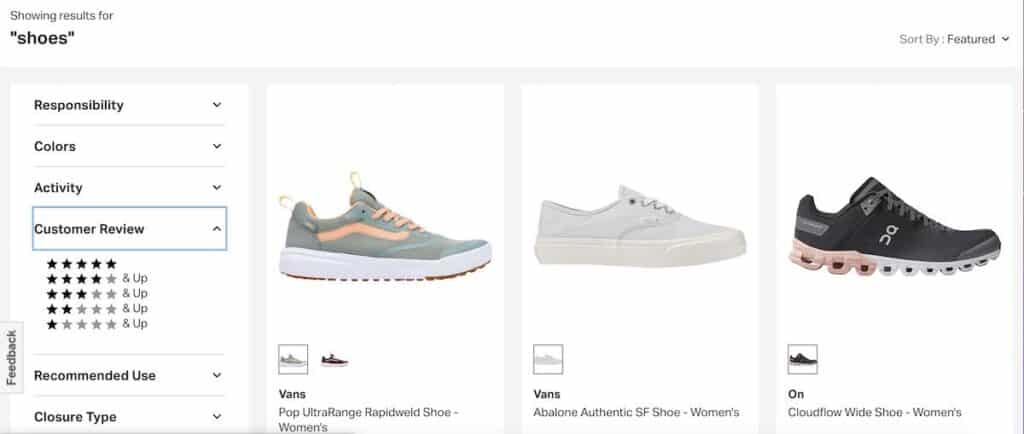
Dynamic, contextual facets
While the categories of search facets above are more broad, sometimes product searches need to get very specific in how they filter attributes. In these cases, it’s important that facets match the context of the search.
For example, a search for “women’s pants” would typically have the common facets like size, color, and style, but it might have other more pant-specific facets like inseam length, rise, leg silhouette, or number of pockets. Those facets would make no sense for a query for “women’s hats,” which might have other hat-specific facets.
Apparel brand Bonobos appropriately provides neck type (crew neck or v-neck) and shirt pockets as facets for a search for “tee”:
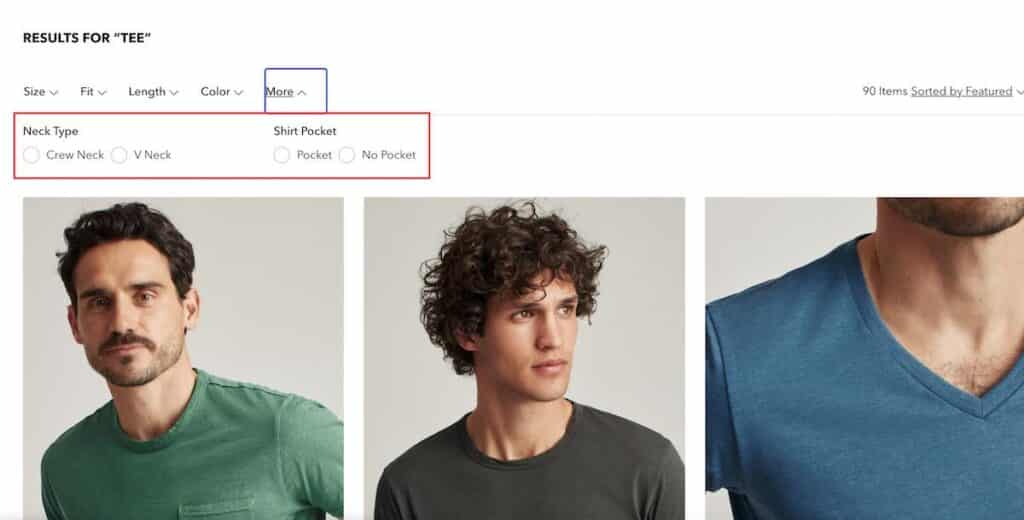
This type of faceting helps shoppers specify more granular preferences, reducing time to purchase and improving conversion rate.
3. In What Order Should You Display Facets?
While facet order can be set globally in your faceted search software, there may be times when you want to slot facets in a different order to further support a contextually relevant facet experience.
In this case, there are two options available to you:
- you can manually slot facets for specific searches given what you know about the context.
- you can use AI-assisted merchandising tools to order your facets in a way that optimizes your search results for conversion, but more on this later.
For example, perhaps size is generally important across most of your site so it has a default position high in the facet listing. But for categories like accessories where most items are one size, you could slot size below more relevant facet groups like color, brand, or price. It will still be present for that category, but it won’t take up valuable space for other more contextually relevant options.
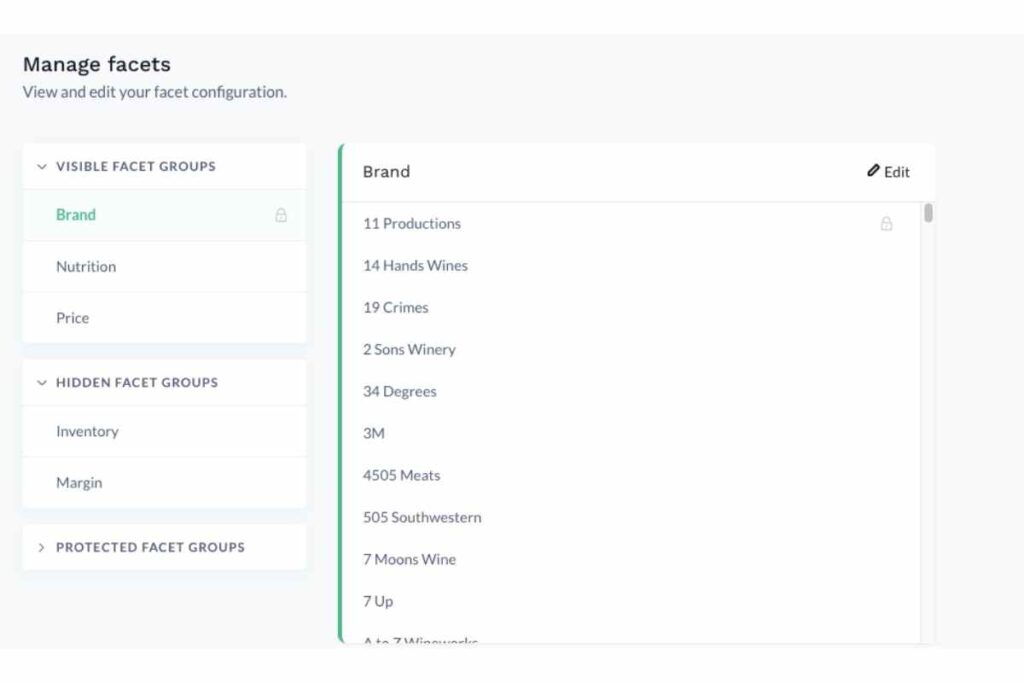
Your faceted search software may provide you with analytics and insights about which facets are used and which are not. If that’s the case, you can also choose to hide the ones that are seldom used to provide a cleaner and more streamlined experience. Some platforms only return facets that match the products in the result set, which means that all of the facets presented will aid users in narrowing their results.
4. Make Facets Easy to Select and Filters Easy to Use
Finally, it’s important to consider your buyer’s shopping experience when they’re in the process of narrowing down search results. Even the slightest frustrations with filtering through attributes could make them decide to jump to another site.
There are a number of ways customers could potentially get confused during their search experience. Keep these in mind when planning your faceted search interface:
Prominently display selected facets
It can be frustrating as a shopper to see only a small selection of products but not remember which facets you’ve selected. At this point they can either go through the facet list and unselect everything… or they can bounce off the site.
Solve this headache by prominently displaying selected facets at the top of the search results page. Here on Rugs Direct, “pillow” is automatically selected as that was the search query, but the shopper refined results further to see only vintage/overdyed pillows. It’s clearly displayed at the top so that they can understand why they’re getting these specific results and easily unfilter if necessary.
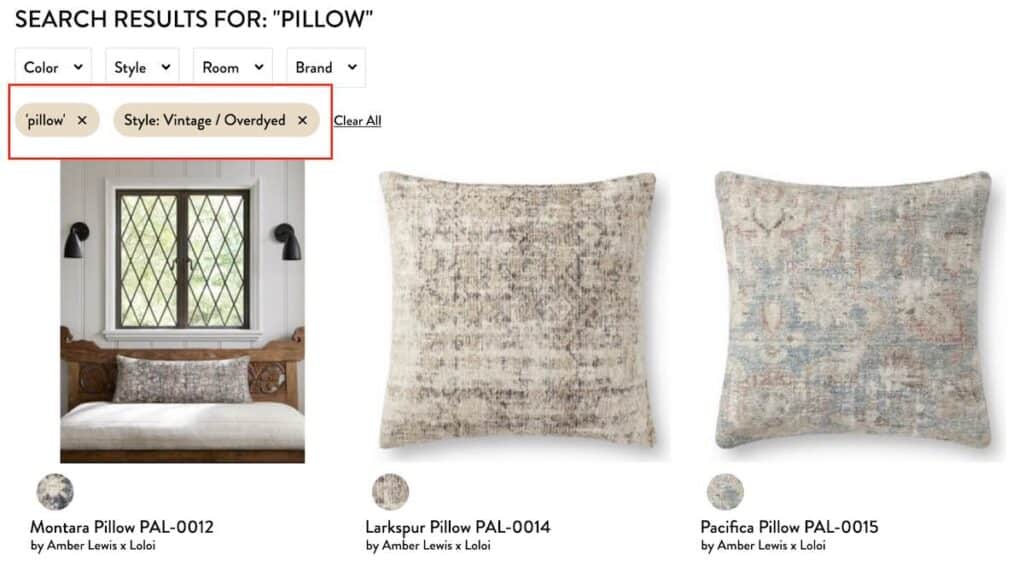
Multiple filters
Are there facets for which it makes sense to select multiple attributes, or are they all mutually exclusive?
Most of the time it makes sense to have checkbox filters so that shoppers can select more than one attribute, e.g., red and yellow. But sometimes you may want to have “radio buttons” instead to show users that only one attribute can be selected at a time (such as a pickup location or fulfillment method).
Make filtering responsive and interactive
Typically, if you have a healthy site speed, it’s best practice to make filtering interactive, meaning that results filter automatically as soon as a selection is clicked. One reason for this is that customers will stop applying filters when they begin to see items they like, and this reduces the chance that they’ll receive unattractive results (or no results) from applying too many unnecessary filters.
See how it works here on Target Australia’s website:
If this isn’t an option with your current ecommerce platform, make sure that the “Apply” button is very clearly displayed so that customers know they’ll have to manually apply the filters they select.
5. Selecting the Right Faceted Search Software
All of these best practices are important, but they can be difficult to implement manually. The right product discovery software can leverage AI and machine learning to automatically order facets, rank products, and optimize for business KPIs.
The best software partners with your ecommerce team, assisting them as they exercise their expertise in each context. After implementing any manual slotting or hiding you’ve already specified, a search solution with advanced searchandising functionality can feature or reorder facets based on a few factors:
- whether the facets match products in the result set
- the attractiveness of the products those facet values are associated with
- the frequency that a given attribute appears across the result set
For example, a product with a rare attribute might rank high in search results due to attractiveness, but its facet value might not rank as high with that rare attribute.
Combining classic capabilities like slotting and hiding facets with this advanced automation consistently drives outsized results, including gains across the board in revenue, margin, and conversion rate.
3 Faceted Search Examples to Copy for Your Site
Faceted search software like Krestor definitely makes creating a great search experience easier. See how these websites are tapping into sophisticated facets and filters to help their customers find products they love:
Backcountry
Outdoor retailer Backcountry knows a thing or two about faceted search. Thousands of people visit their website every day looking for very specific outdoor gear—everything from workout supplements to snowboards. With an extensive catalog across a wide variety of outdoor activities, it’s critical for Backcountry to leverage search effectively.
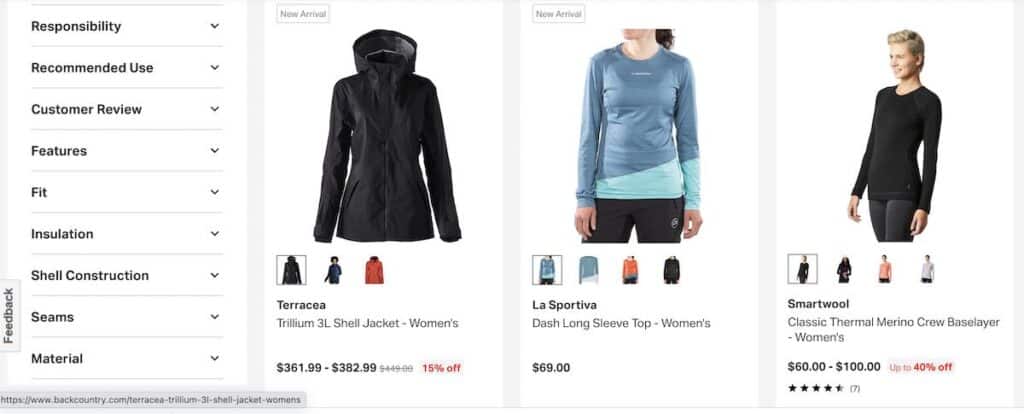
What we love: Backcountry has some of the most detailed contextual facets we’ve seen. For a search for snowboard clothing, customers can filter by everything from seaming and weight to insulation and shell construction. This helps build confidence that the folks at Backcountry know their outdoor gear inside and out, and are dedicated to helping customers find just the right item.
Serena & Lily
Modern furniture company Serena & Lily offers proof that faceted search doesn’t have to mean a clunky or complicated user experience. Their clean filtering for search results opts for collapsed filters by default so that customers can open and select what they’d like.
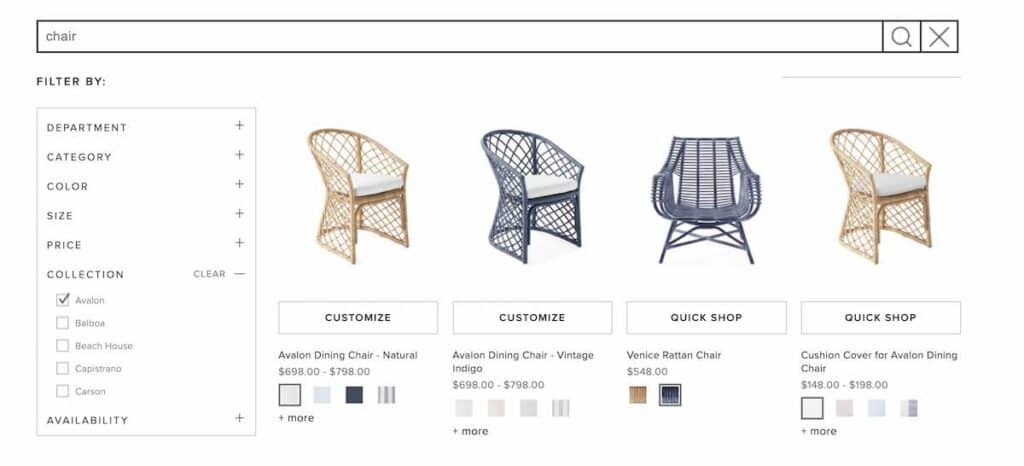
What we love: Serena & Lily understands how people shop for furniture—they look for coordinating pieces and collections. The “Collection” facet above allows shoppers to refine results by collection, seeing all matching pieces in one place. This increases average order value by providing upsell opportunities and builds customer trust in the brand.
LuckyVitamin
Wellness retailer LuckyVitamin understands that the world of supplements and vitamins can sometimes get confusing for customers. In a situation where a single query for “vitamin C” could return hundreds of products, faceted search (combined with AI and machine learning for personalization) provides shoppers with a better experience by allowing them to narrow down those results quickly.
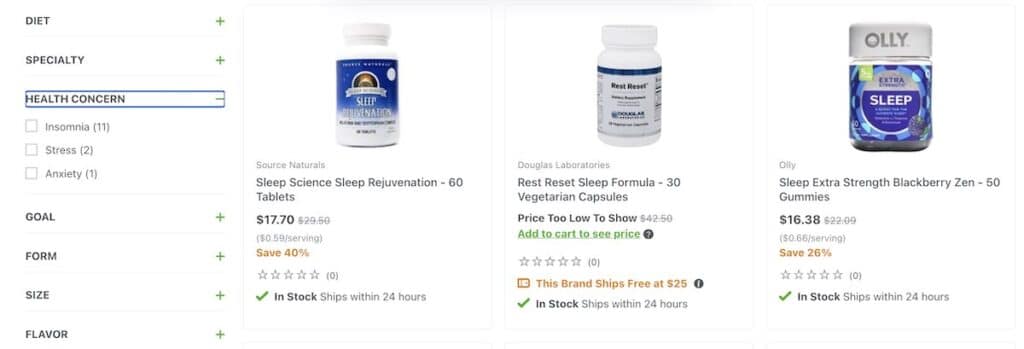
What we love: LuckyVitamin uses lifestyle facets like “diet” and “health concern” to help customers find the right products for their needs. Analyzing what each customer clicks on after refining their search, LuckyVitamin’s product discovery platform uses those insights to make more attractive suggestions in the rest of the site experience and optimize for conversions. For example, clicking on products with the “insomnia” attribute might make products like eye masks or lavender oil show up higher on other pages.
The Next Step in Faceted Search
Faceted search is a powerful tool to help merchandising teams improve the customer experience and drive revenue—but it doesn’t work alone. Some of the optimizations listed here, like dynamic filtering or flexible filter ordering, work best when they’re part of a product discovery system that uses AI and machine learning. These technologies can help surface insights, make optimizations, and automate manual merchandising processes.
Interested in learning how merchandising tools can help your team do more with less? Check out our Guide to AI-Assisted Merchant Tools:
Even Ecommerce Superheroes Need A Sidekick
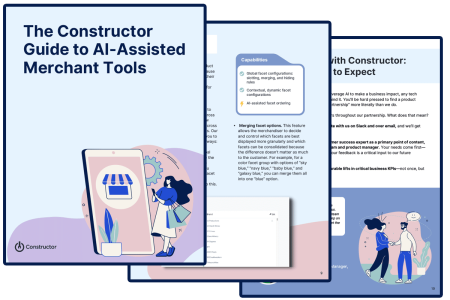
Learn how to reduce your routine work and drive your KPIs with Krestor’s AI-assisted merchant tools.
In this guide, we’ll dive into two areas where Krestor streamlines workstreams for your merchant teams:
- Site search and browse capabilities
- Sitewide product discovery
